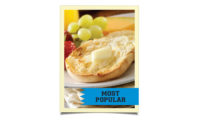Cultured dairy products — dairy products fermented with lactic acid bacteria — have been around for absolutely ages. The COVID-19 pandemic and a bit of innovation on the part of dairy processors, however, have combined to build consumer demand in a number of cultured dairy segments during the past year or so.
Cottage cheese and sour cream are not among the sleepers here, according to Carolina Hoyos, senior marketing manager for Modesto, Calif.-based Crystal Creamery.
“Currently, the market is showing significant growth in both cottage cheese and sour cream,” she says. “Consumers continue to seek out healthy options that fit with their lifestyles. Cottage cheese is naturally high in protein, gluten-free and a good source of calcium.”
As for sour cream, it has been part of the toolkit for home cooks and bakers, who have been stepping it up in the kitchen amid the pandemic, Hoyos notes.
Rebecca Leinenbach, vice president of marketing and communications for Edwardsville, Ill.-headquartered Prairie Farms Dairy Inc., agrees that the pandemic-related surge in home baking and cooking has been a boon to both sour cream and cottage cheese. Refrigerated dips have benefited, too, she adds.
The largest cultured dairy category at retail — yogurt — also has seen an upswing in sales. According to the International Dairy Deli Bakery Association’s Feb. 16, 2021, “COVID-19 Impact Report,” U.S. retail yogurt sales were up 4.6% in the fourth quarter of 2020 versus the same timeframe in 2019. The report cites data from Chicago-based market research firm IRI.
Functional benefits take center stage
To keep the momentum going, cultured dairy processors would be wise to consider a number of key trends playing out within the category.
One emerging trend is a “new era” for gut health and probiotics, says Niel Sandfort, chief innovation officer for Norwich, N.Y.-based Chobani LLC. Driving this new era are scientific advances in the understanding of probiotics’ mode of action, as well as “consumer-led cultural fascination” — basically, “food-obsessed” consumers spreading information by word of mouth about the benefits of the ancient art of fermentation.
“Yogurt fermentation, kimchi, kombucha and pickling have permeated into many U.S. home kitchens and purchases, partially driven by the mega shift in cooking more at home during the pandemic,” he says. “Gut health has gone from an awkward and intimidating term to mainstream appreciation over the past decade. This trend has especially accelerated recently as consumers now grasp that the gut truly is the center of the human machine, affecting multiple functions of the body.”
Jesse Merrill, co-founder and CEO of Good Culture, Irvine, Calif., concurs that there is wider recognition among consumers of the link between gut health and cultured foods.
“So you are seeing a material shift towards products that offer an efficacious dose of live and active cultures with a therapeutic effect,” he adds.
Cultured products with probiotics and other ingredients to promote gut health are part of a larger trend toward functional foods and beverages. As Pedro Silveira — president of U.S. yogurt for White Plains, N.Y.- and Broomfield, Colo.-based Danone North America — explains, functional benefits also encompass things such as high protein content.
Lara Gish, senior category manager, cultured products for Tillamook, Ore.-based Tillamook County Creamery Association, agrees that high-protein formulations are trending within the yogurt segment.
However, functional benefits also could go beyond probiotics and protein.
“An emerging trend within cultured dairy is the addition of new health and wellness benefits that are not traditionally found in yogurt,” explains Katie Erhard, senior brand manager of dairy for Minneapolis-headquartered General Mills. “The pandemic has made consumers more focused on the foods they eat, their immune systems and how food can help with their overall lifestyle.”
Women are experiencing stress and burnout at a rate that is twice of men, Silveira points out.
“Providing ways to help them prioritize their health and wellbeing is critical,” he says.
Other trends have traction, too
Customization is also hot on the yogurt side, Gish says. That trend is shown by the recent upswing in sales for multi-serve containers of plain yogurt.
“People like to create their own yogurt bowls with fresh fruit, nuts and other toppings, and they’re also using it in baking and other recipes,” she says.
Moreover, premium yogurt products boast appeal. Today’s yogurt consumers look for and spend more money on products that offer high-quality ingredients reflecting their values, says Gish.
As for cottage cheese, it’s the comeback kid — and it is not about dieting and deprivation anymore, says Rebecca Heagney, director of marketing for Kemps LLC, St. Paul, Minn. And within the cottage cheese space, flavors and single-serve, grab-and-go options for healthful snacking are the talk-worthy trends.
“[We’ve been] seeing a lot of different flavors emerge in the last few years — everything from savory flavors like chipotle and Parmesan-garlic to sweeter tastes like pineapple and peach,” she shares. “With COVID, we’ve also seen growing interest in exploring new and unique flavors.”
Across the dairy products segment, including cultured dairy, today’s consumers desire a clean-label status and also want to know the source of the products’ ingredients, Hoyos notes. To meet the clean-label trend, Crystal Creamery recently removed the carrageenan from its cottage cheese — without adversely affecting the texture and flavor, she adds.
The clean-label trend could be tied to a trend toward what Heagney calls consumers’ desire for “real” foods.
“Consumers want to know where their foods come from and are looking for more naturally occurring nutritional benefits,” she explains.
Cottage cheese certainly fits in here.
“When it comes to nutrition, cottage cheese has some solid cred — packing protein as well as calcium and potassium,” Heagney adds.
What’s not hot
Cultured dairy processors also would be wise to note a few former trends that have lost their luster. Fat-free formulations, for example, have fallen out of favor with many consumers.
Hoyos says consumers are aware of the number of calories they consume, but they also understand the complementary role fat can play in their diets. Therefore, whole-milk dairy products have been on a growth wave overall during the past few years.
As Merrill explains, consumers desire whole foods with quality ingredients to support “an overall wellness agenda” instead of foods that cut out fat and calories and replace them with empty ingredients that are highly processed.
“Much like we’re seeing with the overall dairy category, ‘fat is back,’ and consumers are embracing more full-fat dairy products, Heagney adds. “Because of this, we’re seeing growth in 4% and 2% milkfat cottage cheese, while fat-free versions are declining.”
Sugar — at least too much of it — is not hot, either. The “2020 Food & Health Survey” from the International Food Information Council found that 74% of Americans were trying to limit or avoid sugars in their diet.
“Products that are rich in protein and lower in sugar remain relevant to consumers, and as such, brands are keeping their sugar levels in check or offering no-added-sugar offerings,” Gish points out.
Lower- or no-sugar options also appeal to consumers on special diets.
“Low-carb diets such as keto are very popular, with consumers focused on limiting sugar and net carbs to meet their weight loss goals,” Erhard says. “In addition, many consumers have health [conditions] such as diabetes that are fueling the demand for low-sugar offerings.”
What’s on-trend in yogurt
Today’s innovative dairy processors are staying on top of the most significant trends. To meet the push toward gut-health-supporting products, Chobani recently debuted the Chobani Probiotics line, Sandfort notes. The line of yogurts and yogurt-based drinks (as well as some nondairy options) aims to go beyond aiding in digestion and regularity, he says, adding that yogurt is the perfect delivery vehicle for probiotics because consumers closely associate the two.
“To limit the narrative to digestion misses the much bigger picture about gut health,” Sandfort explains. “Our new Chobani Probiotics line addresses this by bringing attention to the multiple benefits of these foods and drinks: digestion, immune function and, just as critically, thinking about the foods you put in your body and how that impacts many functions and overall wellbeing.”
Danone North America also put gut health into the spotlight this year, although not with the release of a new product line. Instead, its Activia yogurt brand introduced the Activia Gut Health Challenge, which Silveira says is a “twice-a-day, two-week journey” designed for consumers to support their gut health. The challenge rolled out nationally across major food retail outlets and on social media at the beginning of the year.
“Activia has also funded a study currently underway at Rutgers University that explores the potential connection between the microbiome and COVID-19,” he adds. “As a company, Danone has been studying probiotics, [the] gut and gut health for more than 100 years, and it was important for us to take part in this pioneering study that aims to determine if the microbiome can predict the severity of COVID-19.”
For its part, General Mills hit both the high-protein and reduced-sugar trends with the recent introduction of its :ratio Keto and :ratio Protein yogurt snack lineup. The protein version contains 25 grams of protein and only 3 grams of sugar, the company says, while the keto version offers 15 grams of protein and only 2 grams of total carbs. Both come in a variety of flavors.
Tillamook also aimed for higher protein and lower sugar — as well as consumer customization — with the launch of its new Tillamook Creamery Collection. The line includes six combinations of side-by-side flavors, Gish says, and features reusable cups. Examples of the pairings include Oregon Strawberry paired with Plain and Oregon Blueberry paired with Vanilla.
“With flavors that range between 13 to 14 grams of protein and 9 to 10 grams of sugar, as well as no artificial sweeteners, flavors or preservatives, these yogurts are not too sweet, not too tart and made with the high-quality ingredients snack lovers expect from TCCA,” she says.
Yet another new yogurt launch aims to meet the global trend toward sustainability. The Two Good brand extension — Two Good Good Save — from Danone North America strives to reduce food waste at the farm level, Silveira explains.
“In partnership with Full Harvest, Two Good Good Save uses Verified Rescued Produce to create lower-sugar (2 grams per 5.3-ounce serving) yogurt products,” he says. “The [first] product is a Meyer Lemon yogurt that uses lemons that would have otherwise gone to waste to create a great-tasting product. The product line is one of the early examples of bringing the emerging rescued foods market to a wider scale and is the first dairy product to utilize Verified Rescued Produce.”
What’s on-trend beyond yogurt
Yogurt is not the only cultured dairy category that is investing in on-trend innovation.
On the kefir side, Morton Grove, Ill.-based Lifeway Foods Inc. just added two new lines to its collection of products: 3.5-ounce functional shot multipacks and organic grass-fed kefir, both made with 12 active cultures. The products mesh with consumer interest in gut health and health and wellness overall: They are said to be packed not only with probiotics, but also with protein, calcium and vitamin D.
Good Culture, meanwhile, had sugar reduction, in addition to gut health, in mind when it created its new Good Culture 3G probiotic cottage cheese lineup. The single-serve, fruit-on-the-bottom offerings have only 3 grams of total sugar and zero grams of added sugar, Merrill says.
Good Culture also recently debuted organic probiotic kefir-based smoothies with 35 billion colony-forming units, he adds, as well as probiotics-containing sour cream made from the milk of pasture-raised cows.
And cleaner ingredients have been the focus of Crystal Creamery, notes Brian Carden, senior director of sales.
“Our updated recipes for both cottage cheese and sour cream have simple ingredients consumers understand and trust,” he says. “Also, we are currently working on expanding our innovation pipeline in cultured for continued growth and addressing consumers’ needs and new and emerging market trends.”
For its part, Prairie Farms Dairy aimed to meet the growing shift toward home meal preparation with its new pouch sour cream offering, Leinenbach says.
“Prairie Farms pouch sour cream has the convenience of a flip-open pouch that makes it easy to top off go-to favorites like tacos and baked potatoes,” she says.
And Prairie Farms small-batch cottage cheese cups aim to bring “the perfect combinations of freshness, flavor and convenience” to students and remote workers, Leinenbach adds. The 5-ounce single-serve cups come in seven flavors, including the Zesty Fiesta and Garden Veggie savory options.
Kemps, too, recently debuted new single-serve flavored cottage cheese offerings — under its Kemps Bold brand. The grab-and-go options are high in protein and come in bold flavors such as Bacon Ranch, Jalapeño Cheddar and Bacon Cheddar, Heagney says.
In addition, Kemps introduced its first-ever multi-serve flavored cottage cheese product line under the Kemps brand.
“The 15-ounce containers are made with 4% milkfat cottage cheese and come in four flavors: Cucumber Dill, Garlic Parmesan, Pineapple and Peach,” Heagney says.











